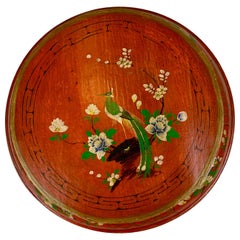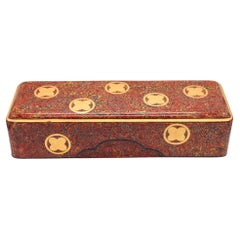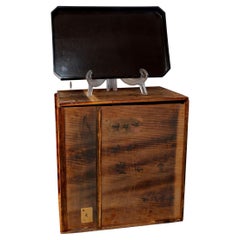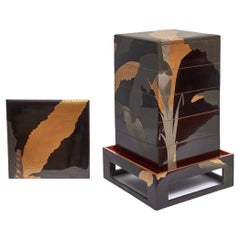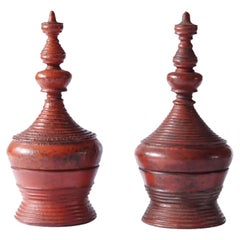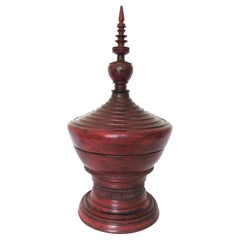Hand-Crafted Lacquer
to
7
52
11
78
2
3
2
1
6
36
36
2
28
4
1
3
2
62
36
25
14
10
74
53
42
16
15
80
79
79
1
1
1
1
Technique: Hand-Crafted
Red Lacquer Chinese Wedding Box- Hand Decorated
Located in West Palm Beach, FL
Chinese red lacquer two part wedding box. Entirely hand decorated with a bird and flowers on top and flowers and vines along the side. The interior is pai...
Category
1890s Chinese Chinoiserie Antique Hand-Crafted Lacquer
Materials
Enamel
$680 Sale Price
20% Off
JAPAN 1900 Meiji Period Fubako Box In Hiramaki-e Lacquered Wood With Gilding
Located in Miami, FL
Fubako letters-box from the Japanese Meiji period (1868-1912).
Beautiful decorative Fubako letters box from the Japanese Imperial Meiji period, circa 1900. This box has been meticul...
Category
Early 1900s Japanese Meiji Antique Hand-Crafted Lacquer
Materials
Gold
Set of 10 Japanese Lacquer Trays, Meiji 36, Circa 1903
Located in Norton, MA
The set of 10 Japanese lacquer trays was made in Japan in the year of Meiji 36. It's 1903 and almost 120 years old. There is the only one that got opened for displaying and the rest ...
Category
Early 20th Century Hand-Crafted Lacquer
Materials
Lacquer
Japanese lacquered 5-tiered jûbako 重箱 (picnic box) with banana leaf design
Located in Amsterdam, NL
Elegant lacquered tiered jûbako (picnic box) comprising five stackable tiers, two covers, and a raised tray. Each bearing an attractive deep chestnut brown ground and lacquered in ta...
Category
Early 20th Century Japanese Hand-Crafted Lacquer
Materials
Giltwood, Lacquer
Pair of Small Burmese Lacquer Offering Vessels, "Hsun Ok", c. 1900
Located in Jimbaran, Bali
This pair of Lacquered Offering Vessels are know in Myanmar as "Hsun Ok". These vessels were once used to carry food and offerings to and from the monastery. T...
Category
Early 20th Century Burmese Other Hand-Crafted Lacquer
Materials
Lacquer, Wood
Early 20th Century Burmese Lacquer Offering Vessel, Hsun Ok
Located in Atlanta, GA
Burmese (Myanmar) lacquer ware has a long tradition dating back to the 13th century. Lacquer in Burma is called “Thitsi” meaning the sap of a Thitsi Tree (Melanhorrea Usitata). Typically, bamboo and wood are used as a frame or base in making lacquer work.
This covered offering vessel is called a “Hsun Ok...
Category
1920s Burmese Vintage Hand-Crafted Lacquer
Materials
Wood, Lacquer
Temple Bell Pot with Copper Band and Black Lacquer
By Robert Kuo
Located in Los Angeles, CA
Antique copper finish on copper band
Hand repousse´
Black lacquer
Contemporary
Limited Edition
Chinese lacquer is a highly regarded art form an...
Category
21st Century and Contemporary Chinese Hand-Crafted Lacquer
Materials
Copper
$12,300 / item
Miniature Japanese Lacquer Ebony Hokkai Hat Box
Located in Norton, MA
A Meiji period a miniature carved ebony hokkai decorated with lots of inlaid elements on the lower band and on the fitted lid and resting on three feet. one small inlay object missin...
Category
19th Century Antique Hand-Crafted Lacquer
Materials
Lacquer
Pair of Small Burmese Red& Black Lacquer Offering Vessels, "Hsun Ok", c. 1900
Located in Jimbaran, Bali
This pair of Small Lacquered Offering Vessels are know in Myanmar as "Hsun Ok". These vessels were once used to carry food and offerings to and from the monast...
Category
Early 20th Century Burmese Other Hand-Crafted Lacquer
Materials
Wood, Lacquer
20th Century Kanshitsu Oke Lacquerware Bowl
Located in Fukuoka, JP
Welcome to our antique lacquerware collection. We are excited to present this stunning Kanshitsu Oke mixing bowl, which dates back to the Showa period of the 20th century. Kanshitsu ...
Category
20th Century Japanese Showa Hand-Crafted Lacquer
Materials
Wood, Lacquer
JAPAN 1880 Meiji Period Tebako Box In Red Lacquered Wood With Abalone Inlaid
Located in Miami, FL
Presentation Tebako box from the Japanese Meiji period (1868-1912).
Beautiful decorative presentation Tebako box from the Japanese Imperial Meiji period, circa 1880. This box has been meticulously crafted in a squared cushioned shape in wood with kara coating Kobayashi red lacquer, gilding, black lacquer and inlaid decorations of abalone shell, Raden. Tebako literally means "portable box", it is a toilet box containing the objects necessary for washing and make-up, especially blush mirror...
Category
1880s Japanese Meiji Antique Hand-Crafted Lacquer
Materials
Abalone, Wool, Lacquer
English Black Lacquered and Gilt Stenciled Figural Pagoda Tea Box, Circa 1810
Located in Charleston, SC
English black lacquered and gilt stenciled figural pagoda hinged tea box with exterior gilt stenciled dragon motif, original interior pewter hand chased figural container with bone k...
Category
1810s English George III Antique Hand-Crafted Lacquer
Materials
Pewter
19th Century Bronze White Rabbit Hand Warmer/Censer, Japan
Located in Point Richmond, CA
Handwarmer/Censer
Japan
circa 19th century
Bronze
Measures: H: 5.5 in x D: 8 in :: 14 cm x 20.3 cm
Happy Tibetan New Year of the Water Rabbit!
...
Category
19th Century Japanese Tribal Antique Hand-Crafted Lacquer
Materials
Metal, Bronze
$800 Sale Price
20% Off
Early 20th Century, Large Burmese Betel Box, “Kun It”
Located in Atlanta, GA
Burmese (Myanmar) Lacquerware has a long tradition dating back to the 13th Century. Lacquer in Burma is called “Thitsi” meaning the sap of a Thitsi Tree (Melanhorrea Usitata). Typica...
Category
Early 20th Century Burmese Hand-Crafted Lacquer
Materials
Bamboo, Lacquer
19th Century Shell Inlaid Black Lacquer Big Chinese Chest Labled "Sunshing"
Located in Brea, CA
19th Century Shell Inlaid Black Lacquer Big Export Chinese Chest Labled inside "Sunshing" and with Bail handles to sides ,14.5 inch long /10.5inch width/11.5 high inch,big chest...
Category
Late 19th Century Chinese Qing Antique Hand-Crafted Lacquer
Materials
Lacquer
Early 20th Century Burmese Lacquered Tray Stand, “Dang lan”
Located in Atlanta, GA
Burmese (Myanmar) lacquer ware has a long tradition dating back to the 13th century. Lacquer in Burma is called “Thitsi” meaning the sap of a Thitsi Tree (Melanhorrea Usitata). Typically, bamboo and wood are used as a frame or base in making lacquer work.
This table tray stand called a “Dang lan” and is used to hold dishes...
Category
Mid-20th Century Burmese Hand-Crafted Lacquer
Materials
Bamboo, Lacquer
Asian Black and Red Round Box Lacquer Offering Vessel Urn
Located in North Hollywood, CA
South Asian Burmese black and red lacquer box, offering vessel urn with compartment for storage.
This round lacquer ware box from Burma is made from bamboo and lacquer.
In Burma (now...
Category
Late 20th Century Burmese Folk Art Hand-Crafted Lacquer
Materials
Bamboo
Highly Decorative Antique Burmese Lacquered Betel Box / Kun-It, Circa 1900
Located in Ottawa, Ontario
The vermillion lacquered cylindrical body decorated overall with repeating bands of curvilinear geometric motifs, the cover lifting to reveal both of its original trays intended to h...
Category
Early 20th Century Burmese Hand-Crafted Lacquer
Materials
Lacquer, Bamboo
6-drawer cabinet of lacquer carved wood and steel from SoShiro Ainu collection
By SoShiro
Located in London, GB
The All Aid Wellness Cabinet from SoShiro’s Ainu collection, a collaboration between award-winning artist Toru Kaizawa and Shiro Muchiri, was initially imagined as a large-scale medi...
Category
2010s Japanese International Style Hand-Crafted Lacquer
Materials
Stainless Steel
A Monumental 19th C. Ryukyu Hariko (Papier Mâché) Vase, Meiji Period (1868-1912)
Located in Ottawa, Ontario
A stunningly attractive & exceptionally large baluster shaped ‘Ryukyu Hariko’ (papier mâché) vase, masterfully decorated overall with hand painted images of a fruiting peach tree ren...
Category
Early 1900s Japanese Meiji Antique Hand-Crafted Lacquer
Materials
Lacquer, Paper
Recently Viewed
View AllMore Ways To Browse
Japanese Comb
Japanese Lacquered Miniature
Japanese Red Lacquer Tray
Japanese Lacquer Plaque
Korean Mother Of Pearl Furniture
Korean Mother Of Pearl
Japanese Lacquer Ware
Antique Chinese Cinnabar Lacquer
Japanese Lacquered Trunk
Chinese Red Lacquer Tray
Red Lacquer Ware
Burmese Lacquer Trays
Japanese Makie Lacquer
Nagasaki Lacquer
Negoro Lacquer
Japanese Cinnabar
Japanese Lacquer Comb
Japanese Sake Set Antique
